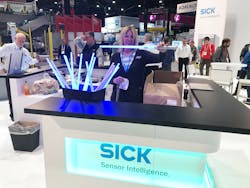CHICAGO – The last time the Material Handling Institute’s (MHI) venerable ProMat show rolled into the vast McCormick Place here, logistics and supply chain attendees bore witness to dozens of exhibitors demonstrating collaborative robotic arms (a k a “cobots”), some of which performed in synchronous fashion (yes, to music) like can-can dancers at the cabaret Le Lido on the Champs-Élysées in Paris.
The year was 2019. You know what happened within 12 months that stifled trade shows and travel opportunities.
Four years later, back in late March, ProMat returned with vigor and volume.
This time, however, while cavorting cobots were present and performing, they were no longer the belle of the ball. That visual recognition passed to automated guided vehicles (AGVs) and autonomous mobile robots (AMRs), transforming ProMat’s extensive footprint spanning the 1.2 million square feet of the North and South Halls into something resembling the Chicago Auto Show’s test tracks occupying the space a month earlier.
Attendance-wise, ProMat also returned with a vengeance. Host MHI reported that the event drew 12% more registered attendees at nearly 51,000 during the four-day event that took place March 20-24, and that international attendee numbers rebounded, representing 178 countries.
Digital supply chain solutions seemed the dominant discussion and education trend among the keynote and seminar tracts as well as the dominant theme woven throughout the booths occupied by 1,051 exhibitors. In fact, key themes centered on automation, robotics, artificial intelligence (AI), autonomous vehicles, augmented reality (AR), the Internet of Things (IoT), and end-to-end data transparency as well as the bread-and-butter products and technology of containers, conveyors, horizontal and vertical carousels, cooling fans and forklifts and a growing number of wearables for computational tracking and physical exertion and posture protection.
In fact, cooling fans are growing even more gigantic, forklifts are sporting more elite and luxuriant automation capabilities and logistics-oriented wearables are transforming warehouse staff into a prototypical version of Marvel’s Iron Man-as-designed-by-supply-chain intelligence. Further, wearables manufacturers are itching to expand beyond the storeroom and warehouse into largely uncharted (but not unknown) areas. Like what? How about the operating room (OR) in surgical services?
MHI also released its 2023 Annual Industry Report, “The Responsible Supply Chain: Transparency, Sustainability, and the Case for Business,” the 10th in a series of annual industry reports published by MHI and Deloitte that “provides updates on the innovative technologies that have the most potential to transform supply chains into more transparent, sustainable, and responsible operations.”
The report highlighted results from a survey of more than 2,000 supply chain professionals that found that 74% of supply chain leaders plan to increase their supply chain technology and innovation investments. Two noteworthy subsets: 90% plan to spend more than $1 million and 36% plan to spend more than $10 million, all of which is geared around improving supply chain resiliency, transparency and sustainability as well as addressing the ongoing labor shortage, according to MHI.
Visit HPN Online for a more complete exhibit hall report on many of the tools and toys trends as well as exclusive interviews with on-site supply chain executives about storeroom and warehouse design challenges tied to this month’s feature on storeroom/warehouse workflow improvements.
About the Author
Rick Dana Barlow
Senior Editor
Rick Dana Barlow is Senior Editor for Healthcare Purchasing News, an Endeavor Business Media publication. He can be reached at [email protected].


